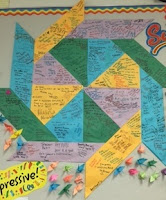Group Participation Feedback
I've mentioned before that my class runs primarily on small, cooperative group work. I organize each group of four students using a variety of methods: ability level, gender, learning styles and (seldom) random. The "teams" collaborate for a unit which culminates in a team test. Each student in the team is assigned a role: Facilitator, Task Manager, Recorder/Reporter & Resource Manager.I'm sure it comes as no surprise that, while in a group, there are those who work diligently and those who don't. I do my best to circulate and observe behaviors during team interactions but I can't observe everything (My gamma ray exposure did not grant me this power.) Thank goodness for tattle tails!! There is always someone in a group that is more than willing to tell me everything that went on, especially if they feel their partners did less than their share of the work. I am not ashamed to say that I not only encourage this, I exploit this tendency. I ask my students to honestly recount their experience working with their teammates. I also encourage them to describe their own participation. I am always surprised at the level of bluntness I get from students. They take this opportunity very seriously, offering specific examples to back up their analysis.
Here is the form I use for daily group work and one I used for a special project.
- Self/Group Evaluation Survey
- Group Work Feedback (Multicultural Fair Project)
Presentation (Peer) Feedback
Recently, my students created a poster incorporating multiple representations of a function. They worked in groups of four and, after the posters were complete, they participated in a gallery walk to observe the posters of other groups and give feedback using a google form. After all the feedback was collected, I was not only able to use it to assist in my assessment of the posters, but I was also able to give the written feedback to each group so they could make revisions.Here is the form I used for their poster feedback.
Data Collection
I recently did an experiment with my students called the Pumpkin Time Bomb. Thirty-seven groups collected pumpkin data including height, weight, circumference, diameter, rind thickness and rubber band dimensions. They also tracked the number of rubber bands needed to make their pumpkin explode. Initially, groups recorded their data on a paper data collection page and then submitted their data, for later use, through a google form. We used the data to make Desmos graphs comparing each variable to the number of rubber bands needed.Here are the forms I used for prediction and data collection.
Rubrics/Grouping
I have the privilege to be a part of our one of my districts magnet programs. FLAGS stands for Foreign Language and Global Studies. The program is geared towards highly motivated middle schoolers interested in taking a foreign language in middle school. A long standing tradition of the program is the Multicultural Fair. This is a one night only event where students, teachers, parents and community members come together to celebrate cultural diversity. Each year, each grade level team of students are tasked to create a project that showcases an area of study. This year the 8th grade team recreated games from around the world.This project was a true team effort for students and teachers alike. The four core subject teachers on our team took an entire school day away from our instruction for our students to work on the components of their project. Here's what we did.
Students were placed into teams of four and assigned a game using a google form. Each group was required to recreate their game, learn about its origin and history, teach others to play the game (in person and through video instructions) and create a Thing-link as the hub of all their work.
During our project day, each teacher had 10-11 groups of students working on the four components of their project. We spent weeks hammering out the details in the hopes that on the day, things would go smoothly and students would be able to walk away with a complete project.
The issue of grading was a big one. Each of the core teachers agreed to incorporate the project grade into our overall class grade. How to share the grades for all the components with each other in the most efficient way possible became the issue. We decided to use google forms, designing a form for each component of the project and sharing the forms with each other. This worked like a dream!! We all have access to the grades for all 44 groups (four parts each).
Here are the forms we used for feedback on each component.
Other
I have a ton of ideas rolling around in my head for using Google Forms. Our site's PD team has used them to gather interest data for future PDs. I want to create one to get feedback from my students on what they liked and didn't like about the course (what worked for them and what didn't). I am in the process of creating one to gather parent information for a number of volunteer assignments within our program and another to gather 6th grade teacher recommendations for program applicants.


























































